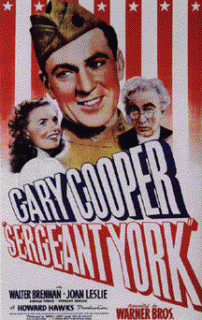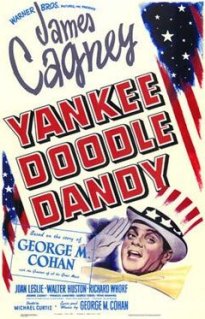
This propaganda extravaganza showcases Hollywood in all its glory from the Brown Derby to the Hollywoodland sign and of course the pride and joy of wartime morale-boosting, the Hollywood Canteen. It’s a bit of a faux reality, Hollywood’s rendition of what real life might actually be like since the Hollywood Canteen did in fact exist.
Historically, it began as an effort by John Garfield and Bette Davis of all people to support the troops and give them quality entertainment from the entertainment capital of the world. Though newsreel footage might serve as a better historical marker (albeit still biased), there’s no questioning the patriotic waves flooding through this picture.
True, even in this film there are anecdotes that point to a slightly different reality. Namely the fact that this was meant to be a Hollywood wide endeavor but all other studios balked and so the lineup is filled out by Warner Bros. catalog of stars and them alone.
Furthermore, it’s easy to surmise that far from being overcome by patriotic fervor, Joan Crawford probably took her role because the alphabetical billing conveniently put her above a couple perennial rivals in Bette Davis and Barbara Stanwyck.
Even with its authenticity in question, there’s no doubt that the film boasts talent. There’s an inexhaustible array of song & dance from the likes of the Andrew Sisters, Roy Rogers (with Trigger) and Jimmy Dorsey. The stars also come out in full force with cameos from everyone conceivably under contract to Warner Bros from Kitty Carlisle, Jack Carson, Joe E. Brown, Ida Lupino, Jack Benny, and of course Peter Lorre and Sidney Greenstreet staying in character. Each one provides enough star power to fill in the idle moments around our main love story.
Still, there’s no doubt that Joan Leslie was one of America’s sweethearts and it’s no coincidence that our protagonist falls head over heels for her all the way in the South Pacific. The pair of lovebirds represents all that is seemingly good and upright about American ideals even if she is a movie star and he is only a common soldier.
That makes the prospect of actually meeting her beyond his wildest dreams, but Hollywood purportedly is in the dream making business and so Slim gets his wishes granted. A date with his dream girl is soon arranged by those tactful matchmakers Davis and Garfield.
Robert Hutton is almost uncannily reminiscent of Jimmy Stewart who was at the time leading bombing raids over Germany. It seems little coincidence that he would then land the crucial role as the universal soldier Slim — a man who saw his share of action and is home for a short spell — before heading out on his next tour of duty.
He represents all the boys fighting for not just the Red, White, and Blue but every color and creed. In his very starry-eyed and candid way, he mentions each one as the camera picks each out of the crowd. Curious the only group not mentioned were members of the Japanese-American infantry. Yet another incongruity with the world at large. But the red carpet that is rolled out for him at the Hollywood Canteen is meant to be only a small recompense for all his service to his country.
Delmer Daves’s picture much like Stage Door Canteen (1943) fits the realm of saccharine propaganda, even blatantly so, but if you allow yourself to be carried away by the historical moment it has its certain charms.
True, the Home Front or the Allied cause isn’t quite as unified and squeaky clean as it claims to be just as humanity on the whole and the stars behind Hollywood rarely could hold up to scrutiny. However, there’s still something here that can make you smile. Publicity stunt or not. Maybe it’s the romantic in me that likes to believe there’s at least a kernel of truth in here and if nothing else there’s honest to goodness sincerity.
3.5/5 Stars

 “My father thanks you, My Mother Thanks you, My Sister Thanks you, and I Thank you.” – James Cagney as George M. Cohan
“My father thanks you, My Mother Thanks you, My Sister Thanks you, and I Thank you.” – James Cagney as George M. Cohan They Drive by Night is a surprisingly engrossing picture and I only mention it for its obvious relation to High Sierra. It came out a year earlier, helmed by Raoul Walsh starring George Raft, Ann Sheridan, Ida Lupino and, of course, Humphrey Bogart. The important fact is that if Walsh had gotten his way, he would have cast Raft again as Hollywood’s perennial tough-guy leading man.
They Drive by Night is a surprisingly engrossing picture and I only mention it for its obvious relation to High Sierra. It came out a year earlier, helmed by Raoul Walsh starring George Raft, Ann Sheridan, Ida Lupino and, of course, Humphrey Bogart. The important fact is that if Walsh had gotten his way, he would have cast Raft again as Hollywood’s perennial tough-guy leading man. He’s not about to lose his nerves or take his eyes off the objective but the two young bucks he’s thrown in with (Alan Curtis and Arthur Kennedy) carry the tough guy bravado well but there hardly as experienced as him. He’s not too happy about the girl (Ida Lupino) they have hanging around either because she’s an obvious liability. In his experience, women squawk too much. The man on the inside (Cornel Wilde) is even worse, a spineless hotel clerk with even less nerve.
He’s not about to lose his nerves or take his eyes off the objective but the two young bucks he’s thrown in with (Alan Curtis and Arthur Kennedy) carry the tough guy bravado well but there hardly as experienced as him. He’s not too happy about the girl (Ida Lupino) they have hanging around either because she’s an obvious liability. In his experience, women squawk too much. The man on the inside (Cornel Wilde) is even worse, a spineless hotel clerk with even less nerve. In an unassuming act of charity, Roy has a doctor friend take a look at Velma and ultimately pays for the surgery that heals her ailment completely. Still, if the story ended there it would be a happy ending but with the heist in the works, Roy is not so lucky. He pulls off the job and makes his getaway but with most any cinematic criminal activity in Hollywood’s Golden Age there must be repercussions. After all, that’s what keeps things interesting and it’s true that Roy and Marie are able to lay low for a time but soon the word is out and the gangster is a wanted man.
In an unassuming act of charity, Roy has a doctor friend take a look at Velma and ultimately pays for the surgery that heals her ailment completely. Still, if the story ended there it would be a happy ending but with the heist in the works, Roy is not so lucky. He pulls off the job and makes his getaway but with most any cinematic criminal activity in Hollywood’s Golden Age there must be repercussions. After all, that’s what keeps things interesting and it’s true that Roy and Marie are able to lay low for a time but soon the word is out and the gangster is a wanted man.
